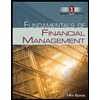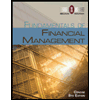
Fundamentals of Corporate Finance
11th Edition
ISBN: 9780077861704
Author: Stephen A. Ross Franco Modigliani Professor of Financial Economics Professor, Randolph W Westerfield Robert R. Dockson Deans Chair in Bus. Admin., Bradford D Jordan Professor
Publisher: McGraw-Hill Education
expand_more
expand_more
format_list_bulleted
Question
Chapter 15, Problem 10CRCT
a)
Summary Introduction
To determine: The prediction of Person X on the price of Company P for the next day and his explanation about the prediction
Introduction:
The private companies offer their stock for the first time to the public and this offering is termed as the initial public offerings. The private company that wants to become a publicly traded company usually proposes the initial public offerings.
b)
Summary Introduction
To determine: The merits of this opportunity
Introduction:
The private companies offer their stock for the first time to the public and this offering is termed as the initial public offerings. The private company that wants to become a publicly traded company usually proposes the initial public offerings.
Expert Solution & Answer
Want to see the full answer?
Check out a sample textbook solution
Students have asked these similar questions
Explain how an increase in interest rates by a central bank could affect bond prices and stock market performance. Explanation.
What is the purpose of diversification in an investment portfolio, and how does it reduce risk?
Explain how an increase in interest rates by a central bank could affect bond prices and stock market performance.
Chapter 15 Solutions
Fundamentals of Corporate Finance
Ch. 15.1 - Prob. 15.1ACQCh. 15.1 - Prob. 15.1BCQCh. 15.2 - What are the basic procedures in selling a new...Ch. 15.2 - What is a registration statement?Ch. 15.3 - Prob. 15.3ACQCh. 15.3 - Why is an initial public offering necessarily a...Ch. 15.4 - Prob. 15.4ACQCh. 15.4 - Prob. 15.4BCQCh. 15.5 - Prob. 15.5ACQCh. 15.5 - Suppose a stockbroker calls you up out of the blue...
Ch. 15.6 - What are some possible reasons why the price of...Ch. 15.6 - Explain why we might expect a firm with a positive...Ch. 15.7 - What are the different costs associated with...Ch. 15.7 - What lessons do we learn from studying issue...Ch. 15.8 - Prob. 15.8ACQCh. 15.8 - What questions must financial managers answer in a...Ch. 15.8 - Prob. 15.8CCQCh. 15.8 - When does a rights offering affect the value of a...Ch. 15.8 - Prob. 15.8ECQCh. 15.9 - What are the different kinds of dilution?Ch. 15.9 - Is dilution important?Ch. 15.10 - What is the difference between private and public...Ch. 15.10 - Prob. 15.10BCQCh. 15.11 - What is shelf registration?Ch. 15.11 - Prob. 15.11BCQCh. 15 - Prob. 15.1CTFCh. 15 - Smythe Enterprises is issuing securities under...Ch. 15 - Prob. 15.4CTFCh. 15 - Prob. 15.7CTFCh. 15 - Debt versus Equity Offering Size [LO2] In the...Ch. 15 - Debt versus Equity Flotation Costs [LO2] Why are...Ch. 15 - Bond Ratings and Flotation Costs [LO2] Why do...Ch. 15 - Underpricing in Debt Offerings [LO2] Why is...Ch. 15 - Prob. 5CRCTCh. 15 - Prob. 6CRCTCh. 15 - Prob. 7CRCTCh. 15 - Prob. 8CRCTCh. 15 - Prob. 9CRCTCh. 15 - Prob. 10CRCTCh. 15 - Prob. 1QPCh. 15 - Prob. 2QPCh. 15 - Rights [LO4] Red Shoe Co. has concluded that...Ch. 15 - Prob. 4QPCh. 15 - Calculating Flotation Costs [LO3] The Valhalla...Ch. 15 - Prob. 6QPCh. 15 - Prob. 7QPCh. 15 - Prob. 8QPCh. 15 - Dilution [LO3] Eaton, Inc., wishes to expand its...Ch. 15 - Prob. 10QPCh. 15 - Dilution [LO3] In the previous problem, what would...Ch. 15 - Prob. 12QPCh. 15 - Value of a Right [LO4] Show that the value of a...Ch. 15 - Prob. 14QPCh. 15 - Prob. 15QPCh. 15 - Prob. 1MCh. 15 - Prob. 2MCh. 15 - Prob. 3MCh. 15 - Prob. 4M
Knowledge Booster
Similar questions
- What is the purpose of diversification in an investment portfolio, and how does it reduce risk? Need help!arrow_forwardWhat are the key differences between a company’s income statement and its cash flow statement? Why are both important for financial analysis? Need help!arrow_forwardWhat are the key differences between a company’s income statement and its cash flow statement? Why are both important for financial analysis?arrow_forward
- What is the relationship between risk and return in finance, and how is this reflected in the Capital Asset Pricing Model (CAPM)? Explain.arrow_forwardDefine the time value of money (TVM). How does TVM influence decision-making in capital budgeting? Explanation.arrow_forwardWhat is the relationship between risk and return in finance, and how is this reflected in the Capital Asset Pricing Model (CAPM)?arrow_forward
- 3. Explain the concept of compounding. How does compounding impact the future value of an investment? Need help!arrow_forward3. Explain the concept of compounding. How does compounding impact the future value of an investment?arrow_forwardWhat is the difference between a stock and a bond, and how do they function as investment options? Need help now !arrow_forward
- What is the difference between a stock and a bond, and how do they function as investment options? Rxplarrow_forwardWhat does the internal rate of return (IRR) tell you about a potential investment? Rxarrow_forwardWhy is the Weighted Average Cost of Capital (WACC) important for a company's decision-making? Explanation.arrow_forward
arrow_back_ios
SEE MORE QUESTIONS
arrow_forward_ios
Recommended textbooks for you

 Fundamentals of Financial Management (MindTap Cou...FinanceISBN:9781337395250Author:Eugene F. Brigham, Joel F. HoustonPublisher:Cengage Learning
Fundamentals of Financial Management (MindTap Cou...FinanceISBN:9781337395250Author:Eugene F. Brigham, Joel F. HoustonPublisher:Cengage Learning Fundamentals of Financial Management (MindTap Cou...FinanceISBN:9781285867977Author:Eugene F. Brigham, Joel F. HoustonPublisher:Cengage Learning
Fundamentals of Financial Management (MindTap Cou...FinanceISBN:9781285867977Author:Eugene F. Brigham, Joel F. HoustonPublisher:Cengage Learning Fundamentals of Financial Management, Concise Edi...FinanceISBN:9781285065137Author:Eugene F. Brigham, Joel F. HoustonPublisher:Cengage Learning
Fundamentals of Financial Management, Concise Edi...FinanceISBN:9781285065137Author:Eugene F. Brigham, Joel F. HoustonPublisher:Cengage Learning




Fundamentals of Financial Management (MindTap Cou...
Finance
ISBN:9781337395250
Author:Eugene F. Brigham, Joel F. Houston
Publisher:Cengage Learning

Fundamentals of Financial Management (MindTap Cou...
Finance
ISBN:9781285867977
Author:Eugene F. Brigham, Joel F. Houston
Publisher:Cengage Learning

Fundamentals of Financial Management, Concise Edi...
Finance
ISBN:9781285065137
Author:Eugene F. Brigham, Joel F. Houston
Publisher:Cengage Learning